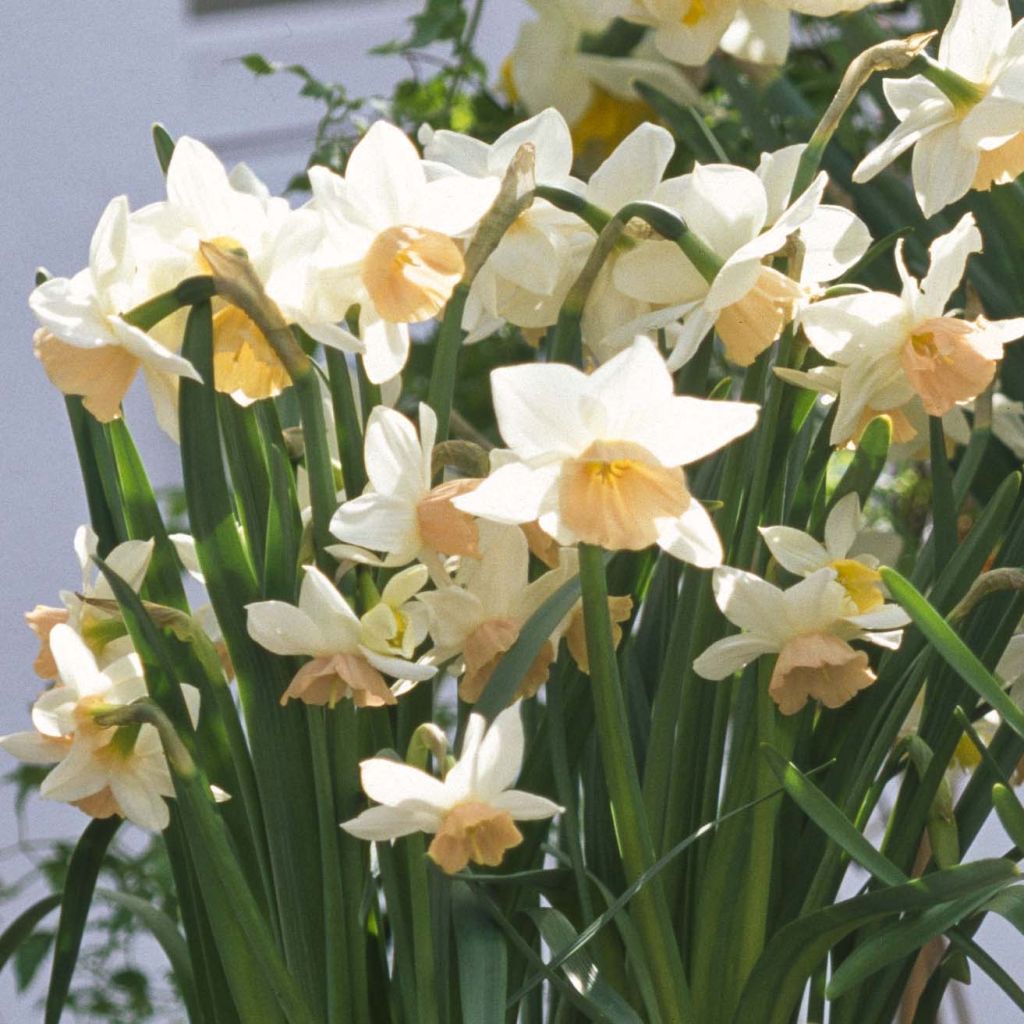

Narcisse Katie Heath
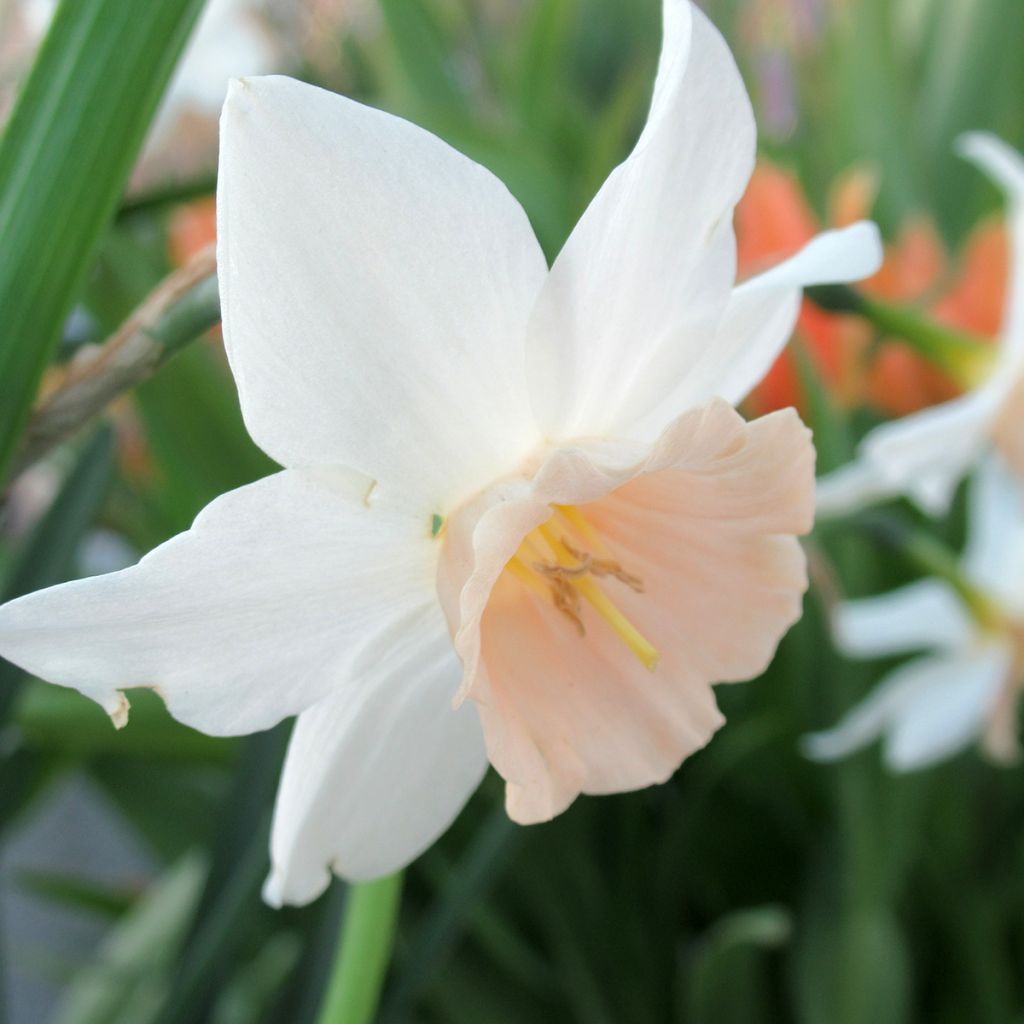

Narcisse Katie Heath
Narcissus Katie Heath
Narcissus x triandus Katie Heath
Angel's Tears, Angel's Tears Daffodil
lovely, healthy bulbs
gerard, 28/11/2019
This plant carries a 6 months recovery warranty
More information
We guarantee the quality of our plants for a full growing cycle, and will replace at our expense any plant that fails to recover under normal climatic and planting conditions.
From €5.90 for pickup delivery and €6.90 for home delivery
Express home delivery from €8.90.

Does this plant fit my garden?
Set up your Plantfit profile →
Description
Katie Heath Narcissus, a hybrid of Narcissus triandus, is a very romantic American novelty. Gracefully swaying on each stem are two or three small flowers displaying a wide frilled blush-pink trumpet crown, set on a pure white, slightly curved corolla. This variety prefers to be planted in a warm location to bring out its light pink colour and naturalises over the years without any maintenance.
The Katie Heath Narcissus is a descendant of Narcissus triandus, charmingly called Angel Tears Narcissus, or Narcissus of Glénan. This species, widespread in Spain, Portugal, and France, is endemic to Finistère. Katie Health is part of a new series of American hybrids. It forms a clump reaching about 35 cm (14in) high when flowering. Its flowers are grouped in twos or threes at the end of each stem. It is a rather late-flowering plant, in April-May, with yellow-green flower buds that open into pretty pastel-toned flowers, drooping towards the ground. The 'trumpet' starts with an apricot shade at blooming, then matures into a distinct blush pink, resulting in a combination of white, pink, cream, and orange on the same clump. The foliage is deciduous and disappears in summer. The abundant, uniform flowers attract pollinating insects. This variety easily multiplies by producing bulblets, forming large clumps over time. Katie Heath Narcissus belongs to division 5 of the larger narcissus family, which includes 12 divisions.
Katie Heath Narcissus is undemanding and grows in any well-drained and well-worked soil, although the results are less favourable in excessively wet or acidic soils. There is such a variety of daffodil cultivars that one can enjoy them for three months in spring without ever getting bored. They can all naturalise easily, have a love for yellow and white, and often emit sweet fragrances. These are all reasons to grow them in large clumps (at least 20 bulbs) for a mass effect. Grow 'Katie Heath' in natural-looking flower beds, with scilla and hyacinths, double tulips, forget-me-nots, pansies, or liverworts. A bunch of 'Katie Heath' narcissus in a vase will look sensational. This narcissus is perfect in pots.
Daffodils are narcissus, belonging to division 7 of the group. Native to southern Europe and North Africa, they have flowers grouped in twos or more. Botanical species that have kept the charm of wild plants and thrive in rock gardens: N. bulbocodium, N. canaliculatus, N. juncifolius, N. pseudonarcissus and the simple wood daffodil are among the most beautiful. In vases, we advise against mixing daffodils with other flowers such as tulips, as the stems of daffodils contain a substance that causes other flowers to wilt quickly. This detrimental effect on other flower types can be mitigated by dipping the ends of the daffodil stems in hot water for 1 to 2 minutes.
Report an error about the product description
Narcissus Katie Heath in pictures
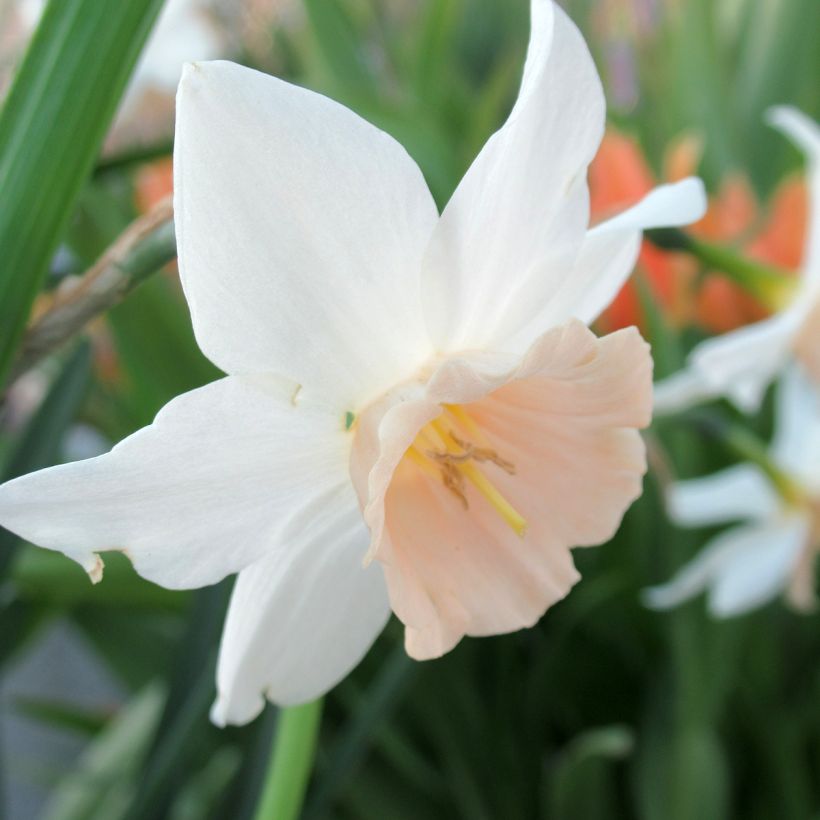

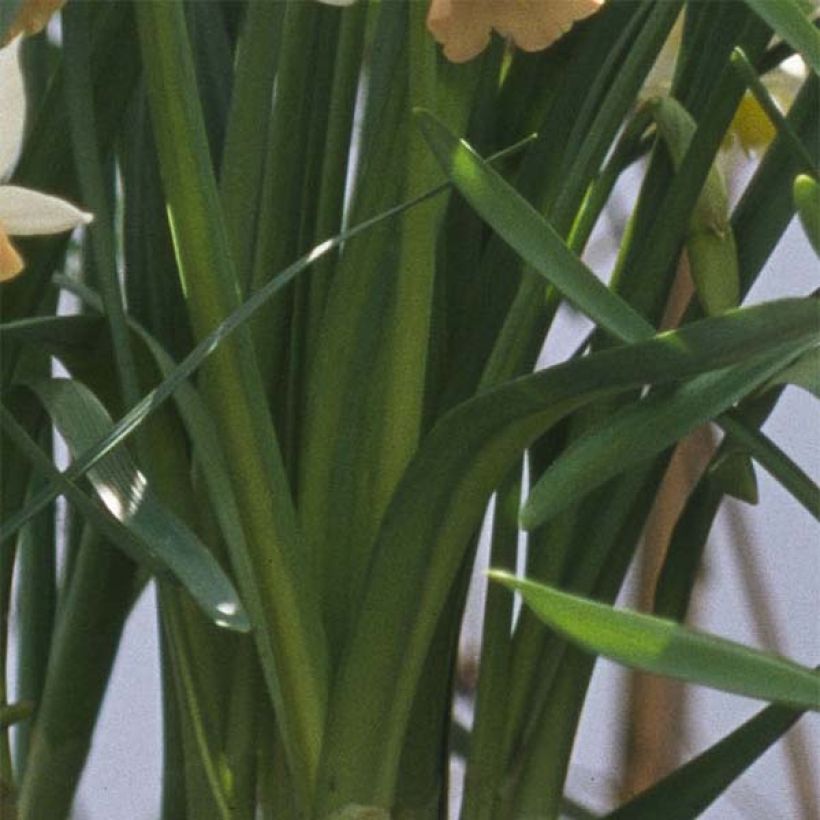

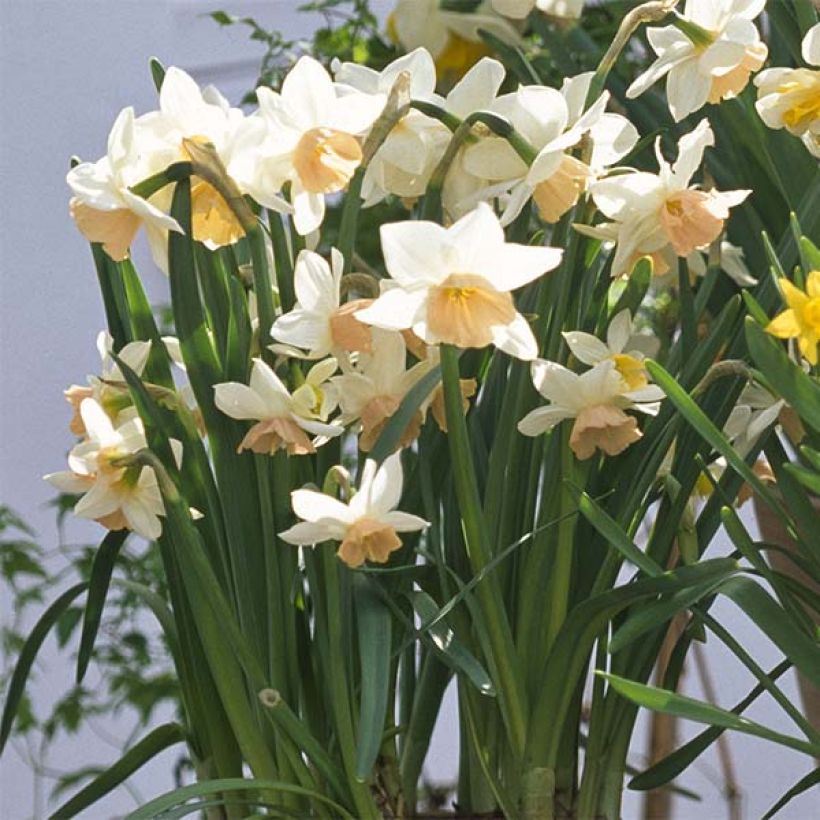

Plant habit
Flowering
Foliage
Botanical data
Narcissus
x triandus
Katie Heath
Amaryllidaceae
Angel's Tears, Angel's Tears Daffodil
Cultivar or hybrid
Planting and care
Daffodils bloom from March to May and return every year. They are easy to grow and will thrive both in partial shade and a sunny flower bed, which is better for certain varieties like Katie Heath. Choose well-drained and well-worked soil and plant them 10 cm (4in) deep and 10 cm (4in) apart in minimum clusters of 5 bulbs, in uniform or mixed colours. To plant them in a lawn: lift a patch of turf, dig and till the soil to a depth of at least 20 cm (8in) (the height of a spade), place your bulbs, cover them with soil, and replace the turf. Choose a spot where you won't mow too early, as you must let the daffodil leaves wither before cutting them. This is when the bulb replenishes itself and prepares for the following year's flowers. Remove the flowers as soon as they fade to prevent seed formation which would deplete the bulb.
Planting period
Intended location
Care
-
, onOrder confirmed
Reply from on Promesse de fleurs
Haven't found what you were looking for?
Hardiness is the lowest winter temperature a plant can endure without suffering serious damage or even dying. However, hardiness is affected by location (a sheltered area, such as a patio), protection (winter cover) and soil type (hardiness is improved by well-drained soil).

Photo Sharing Terms & Conditions
In order to encourage gardeners to interact and share their experiences, Promesse de fleurs offers various media enabling content to be uploaded onto its Site - in particular via the ‘Photo sharing’ module.
The User agrees to refrain from:
- Posting any content that is illegal, prejudicial, insulting, racist, inciteful to hatred, revisionist, contrary to public decency, that infringes on privacy or on the privacy rights of third parties, in particular the publicity rights of persons and goods, intellectual property rights, or the right to privacy.
- Submitting content on behalf of a third party;
- Impersonate the identity of a third party and/or publish any personal information about a third party;
In general, the User undertakes to refrain from any unethical behaviour.
All Content (in particular text, comments, files, images, photos, videos, creative works, etc.), which may be subject to property or intellectual property rights, image or other private rights, shall remain the property of the User, subject to the limited rights granted by the terms of the licence granted by Promesse de fleurs as stated below. Users are at liberty to publish or not to publish such Content on the Site, notably via the ‘Photo Sharing’ facility, and accept that this Content shall be made public and freely accessible, notably on the Internet.
Users further acknowledge, undertake to have ,and guarantee that they hold all necessary rights and permissions to publish such material on the Site, in particular with regard to the legislation in force pertaining to any privacy, property, intellectual property, image, or contractual rights, or rights of any other nature. By publishing such Content on the Site, Users acknowledge accepting full liability as publishers of the Content within the meaning of the law, and grant Promesse de fleurs, free of charge, an inclusive, worldwide licence for the said Content for the entire duration of its publication, including all reproduction, representation, up/downloading, displaying, performing, transmission, and storage rights.
Users also grant permission for their name to be linked to the Content and accept that this link may not always be made available.
By engaging in posting material, Users consent to their Content becoming automatically accessible on the Internet, in particular on other sites and/or blogs and/or web pages of the Promesse de fleurs site, including in particular social pages and the Promesse de fleurs catalogue.
Users may secure the removal of entrusted content free of charge by issuing a simple request via our contact form.
The flowering period indicated on our website applies to countries and regions located in USDA zone 8 (France, the United Kingdom, Ireland, the Netherlands, etc.)
It will vary according to where you live:
- In zones 9 to 10 (Italy, Spain, Greece, etc.), flowering will occur about 2 to 4 weeks earlier.
- In zones 6 to 7 (Germany, Poland, Slovenia, and lower mountainous regions), flowering will be delayed by 2 to 3 weeks.
- In zone 5 (Central Europe, Scandinavia), blooming will be delayed by 3 to 5 weeks.
In temperate climates, pruning of spring-flowering shrubs (forsythia, spireas, etc.) should be done just after flowering.
Pruning of summer-flowering shrubs (Indian Lilac, Perovskia, etc.) can be done in winter or spring.
In cold regions as well as with frost-sensitive plants, avoid pruning too early when severe frosts may still occur.
The planting period indicated on our website applies to countries and regions located in USDA zone 8 (France, United Kingdom, Ireland, Netherlands).
It will vary according to where you live:
- In Mediterranean zones (Marseille, Madrid, Milan, etc.), autumn and winter are the best planting periods.
- In continental zones (Strasbourg, Munich, Vienna, etc.), delay planting by 2 to 3 weeks in spring and bring it forward by 2 to 4 weeks in autumn.
- In mountainous regions (the Alps, Pyrenees, Carpathians, etc.), it is best to plant in late spring (May-June) or late summer (August-September).
The harvesting period indicated on our website applies to countries and regions in USDA zone 8 (France, England, Ireland, the Netherlands).
In colder areas (Scandinavia, Poland, Austria...) fruit and vegetable harvests are likely to be delayed by 3-4 weeks.
In warmer areas (Italy, Spain, Greece, etc.), harvesting will probably take place earlier, depending on weather conditions.
The sowing periods indicated on our website apply to countries and regions within USDA Zone 8 (France, UK, Ireland, Netherlands).
In colder areas (Scandinavia, Poland, Austria...), delay any outdoor sowing by 3-4 weeks, or sow under glass.
In warmer climes (Italy, Spain, Greece, etc.), bring outdoor sowing forward by a few weeks.


































